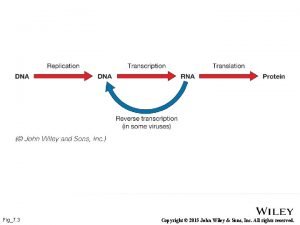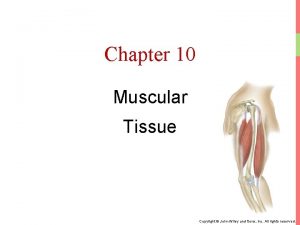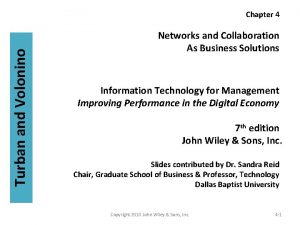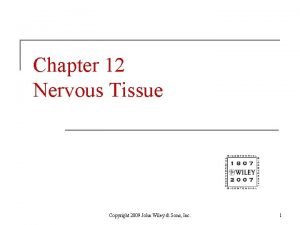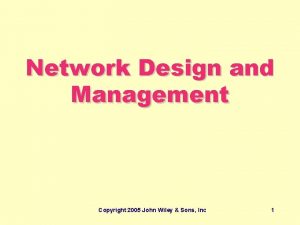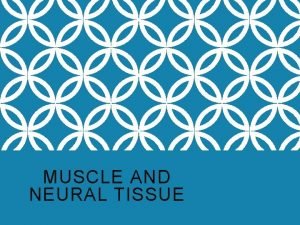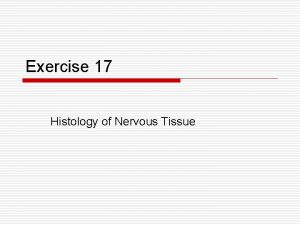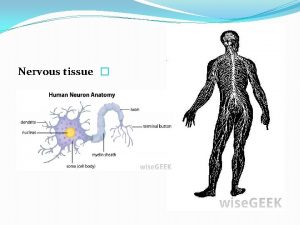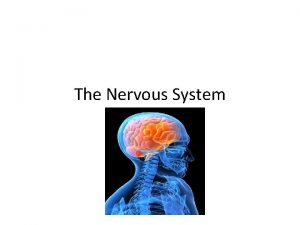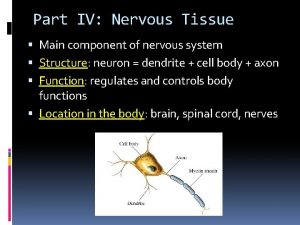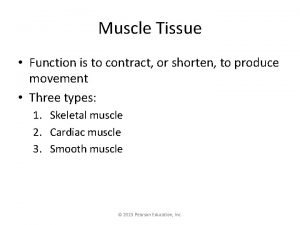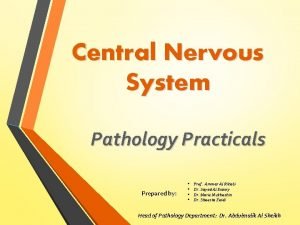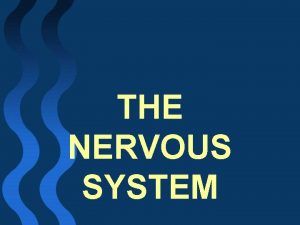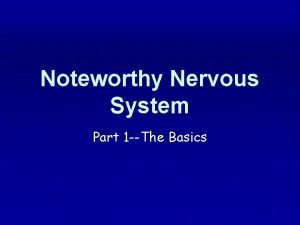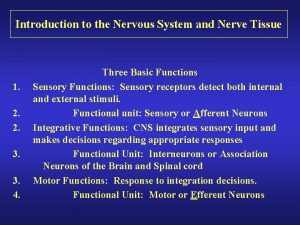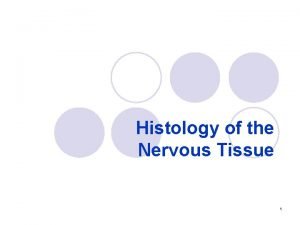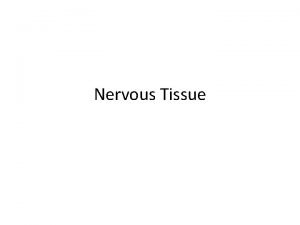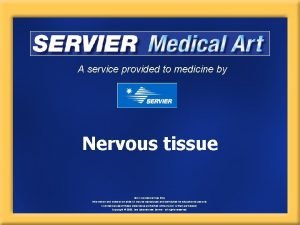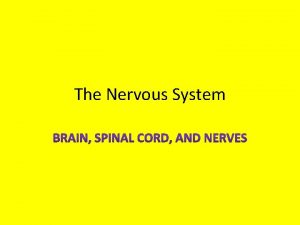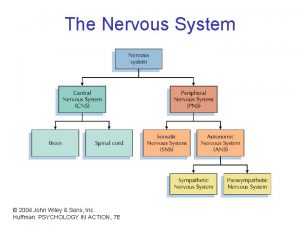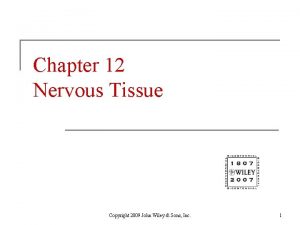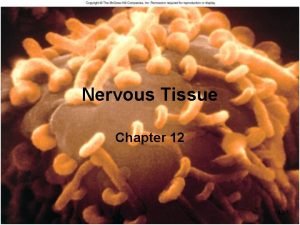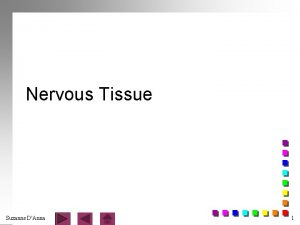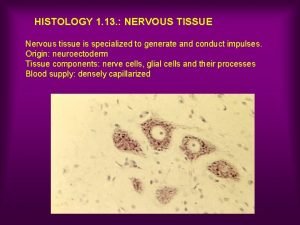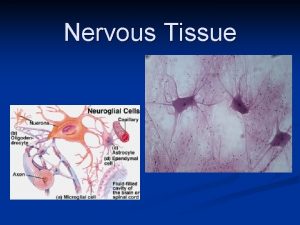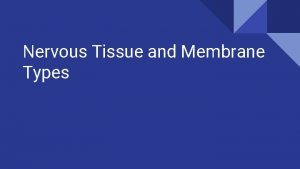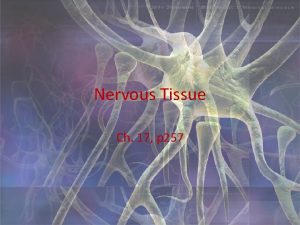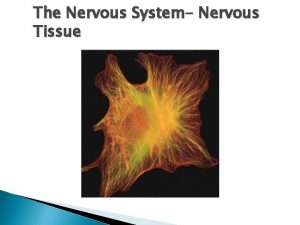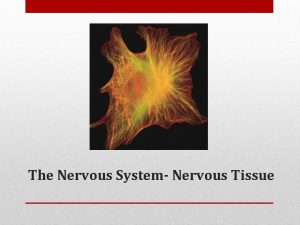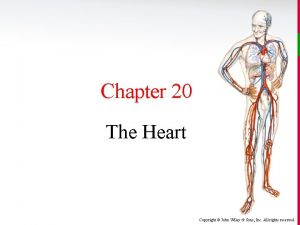Chapter 9 Nervous Tissue 2013 John Wiley Sons






























- Slides: 30

Chapter 9: Nervous Tissue © 2013 John Wiley & Sons, Inc. All rights reserved.

Nervous Tissue n n Overview of the nervous system Histology of nervous tissue Action potentials Synaptic transmission © 2013 John Wiley & Sons, Inc. All rights reserved.

Overview of the Nervous System q The central nervous system (CNS) consists of the brain and spinal cord. The peripheral nervous system (PNS) consists of all nervous tissue outside the CNS. q Components of the PNS include the somatic nervous system (SNS), autonomic nervous system (ANS), and enteric nervous system (ENS). q The SNS consists of sensory neurons that conduct impulses from somatic and special sense receptors to the CNS and motor neurons from the CNS to skeletal muscles. q The ANS contains sensory neurons from visceral organs and motor neurons that convey impulses from the CNS to smooth muscle tissue, cardiac muscle tissue, and glands. © 2013 John Wiley & Sons, Inc. All rights reserved.

Overview of the Nervous System q The ENS consists of neurons in enteric plexuses in the gastrointestinal (GI) tract that function somewhat independently of the ANS and CNS. The ENS monitors sensory changes in and controls operation of the GI tract. q Three basic functions of the nervous system are detecting stimuli (sensory function); analyzing, integrating, and storing sensory information (integrative function); and responding to integrative decisions (motor function). © 2013 John Wiley & Sons, Inc. All rights reserved.

Overview of the Nervous System © 2013 John Wiley & Sons, Inc. All rights reserved.

Overview of the Nervous System © 2013 John Wiley & Sons, Inc. All rights reserved.

Anatomy Overview: • Nervous System You must be connected to the internet to run this animation. © 2013 John Wiley & Sons, Inc. All rights reserved.

Histology of Nervous Tissue q Nervous tissue consists of two types of cells: neurons and neuroglia. Neurons are cells specialized for nerve impulse conduction and provide most of the unique functions of the nervous system, such as sensing, thinking, remembering, controlling muscle activity, and regulating glandular secretions. Neuroglia support, nourish, and protect the neurons and maintain homeostasis in the interstitial fluid that bathes neurons. q Most neurons have three parts. The dendrites are the main receiving or input region. Integration occurs in the cell body. The output part typically is a single axon, which conducts nerve impulses toward another neuron, a muscle fiber, or a gland cell. q On the basis of their structure, neurons are classified as multipolar, bipolar, or unipolar. © 2013 John Wiley & Sons, Inc. All rights reserved.

Histology of Nervous Tissue q Neurons are functionally classified as sensory (afferent) neurons, motor (efferent) neurons, and interneurons. Sensory neurons carry sensory information into the CNS. Motor neurons carry information out of the CNS to effectors (muscles and glands). Interneurons are located within the CNS between sensory and motor neurons. q Neuroglia support, nurture, and protect neurons and maintain the interstitial fluid that bathes them. Neuroglia in the CNS include astrocytes, oligodendrocytes, microglia, and ependymal cells. Neuroglia in the PNS include Schwann cells and satellite cells. q Two types of neuroglia produce myelin sheaths: Oligodendrocytes myelinate axons in the CNS, and Schwann cells myelinate axons in the PNS. © 2013 John Wiley & Sons, Inc. All rights reserved.

Anatomy Overview: • Nervous Tissue You must be connected to the internet to run this animation. © 2013 John Wiley & Sons, Inc. All rights reserved.

Histology of Nervous Tissue q White matter consists of aggregates of myelinated axons: gray matter contains cell bodies, dendrites, and axon terminals of neurons, unmyelinated axons, and neuroglia. q In the spinal cord, gray matter forms an H-shaped inner core that is surrounded by white matter. In the brain, a thin, superficial shell of gray matter covers the cerebrum and cerebellum. © 2013 John Wiley & Sons, Inc. All rights reserved.

Histology of Nervous Tissue n Clusters of Neuronal Cell Bodies q n A ganglion (plural is ganglia) refers to a cluster of neuronal cell bodies located in the PNS. As mentioned earlier, ganglia are closely associated with cranial and spinal nerves. By contrast, a nucleus is a cluster of neuronal cell bodies located in the CNS. Bundles of Axons q A nerve is a bundle of axons that is located in the PNS. Cranial nerves connect the brain to the periphery; spinal nerves connect the spinal cord to the periphery. A tract is a bundle of axons that is located in the CNS. Tracts interconnect neurons in the spinal cord and brain. © 2013 John Wiley & Sons, Inc. All rights reserved.

Histology of Nervous Tissue © 2013 John Wiley & Sons, Inc. All rights reserved.

Animation: • Introduction to Structure and Function of the Nervous System You must be connected to the internet to run this animation. © 2013 John Wiley & Sons, Inc. All rights reserved.

Histology of Nervous Tissue © 2013 John Wiley & Sons, Inc. All rights reserved.

Histology of Nervous Tissue © 2013 John Wiley & Sons, Inc. All rights reserved.

Histology of Nervous Tissue © 2013 John Wiley & Sons, Inc. All rights reserved.

Action Potentials n Neurons communicate with one another using nerve action potentials, also called nerve impulses. n Generation of action potentials depends on the existence of a membrane potential and the presence of voltage-gated channels for Na+ and K+. n A typical value for the resting membrane potential (difference in electrical charge across the plasma membrane) is – 70 m. V. A cell that exhibits a membrane potential is polarized. n The resting membrane potential arises due to an unequal distribution of ions on either side of the plasma membrane and a higher membrane permeability to K+ than to Na+. The level of K+ is higher inside and the level of Na+ is higher outside, a situation that is maintained by sodium–potassium pumps. © 2013 John Wiley & Sons, Inc. All rights reserved.

Action Potentials q During an action potential, voltage-gated Na+ and K+ channels open in sequence. Opening of voltage-gated Na+ channels results in depolarization, the loss and then reversal of membrane polarization (from – 70 m. V to +30 m. V). Then, opening of voltage-gated K+ channels allows repolarization, recovery of the membrane potential to the resting level. q According to the all-or-none principle, if a stimulus is strong enough to generate an action potential, the impulse generated is of a constant size. q During the refractory period, another action potential cannot be generated. © 2013 John Wiley & Sons, Inc. All rights reserved.

Action Potentials q Nerve impulse conduction that occurs as a step-by-step process along an unmyelinated axon is called continuous conduction. In saltatory conduction, a nerve impulse “leaps” from one node of Ranvier to the next along a myelinated axon. q Axons with larger diameters conduct impulses faster than those with smaller diameters; myelinated axons conduct impulses faster than unmyelinated axons. © 2013 John Wiley & Sons, Inc. All rights reserved.

Action Potentials © 2013 John Wiley & Sons, Inc. All rights reserved.

Action Potentials © 2013 John Wiley & Sons, Inc. All rights reserved.

Action Potentials © 2013 John Wiley & Sons, Inc. All rights reserved.

Animation: • Membrane Potentials You must be connected to the internet to run this animation. © 2013 John Wiley & Sons, Inc. All rights reserved.

Synaptic Transmission q Neurons communicate with other neurons and with effectors at synapses in a series of events known as synaptic transmission. q At a synapse, a neurotransmitter is released from a presynaptic neuron into the synaptic cleft and then binds to receptors on the plasma membrane of the postsynaptic neuron. q An excitatory neurotransmitter depolarizes the postsynaptic neuron’s membrane, brings the membrane potential closer to threshold, and increases the chance that one or more action potentials will arise. An inhibitory neurotransmitter hyperpolarizes the membrane of the postsynaptic neuron, thereby inhibiting action potential generation. © 2013 John Wiley & Sons, Inc. All rights reserved.

Animation: • Events at the Synapse You must be connected to the internet to run this animation. © 2013 John Wiley & Sons, Inc. All rights reserved.

Synaptic Transmission q Neurotransmitter is removed in three ways: diffusion, enzymatic destruction, and reuptake by neurons or neuroglia. q Important neurotransmitters include acetylcholine, glutamate, aspartate, gamma aminobutyric acid (GABA), glycine, norepinephrine, dopamine, serotonin, neuropeptides, and nitric oxide. © 2013 John Wiley & Sons, Inc. All rights reserved.

Anatomy Overview: • Neurotransmitters You must be connected to the internet to run this animation. © 2013 John Wiley & Sons, Inc. All rights reserved.

Synaptic Transmission © 2013 John Wiley & Sons, Inc. All rights reserved.

End of Chapter 9 Copyright 2013 John Wiley & Sons, Inc. All rights reserved. Reproduction or translation of this work beyond that permitted in section 117 of the 1976 United States Copyright Act without express permission of the copyright owner is unlawful. Request for further information should be addressed to the Permission Department, John Wiley & Sons, Inc. The purchaser may make back-up copies for his/her own use only and not for distribution or resale. The Publishers assumes no responsibility for errors, omissions, or damages caused by the use of these programs or from the use of the information herein. © 2013 John Wiley & Sons, Inc. All rights reserved.
 John wiley & sons
John wiley & sons John wiley & sons
John wiley & sons Chapter 10 muscle tissue
Chapter 10 muscle tissue Copyright search
Copyright search Thermodynamic control
Thermodynamic control John wiley and sons
John wiley and sons Fundamentals of the nervous system and nervous tissue
Fundamentals of the nervous system and nervous tissue Sensory input and motor output
Sensory input and motor output Processes of a neuron
Processes of a neuron Tubuloglomerular feedback
Tubuloglomerular feedback There were a man who had four sons
There were a man who had four sons A man had four sons
A man had four sons John wiley
John wiley Characteristics of nerve cell
Characteristics of nerve cell Nervous tissue histology ppt
Nervous tissue histology ppt Sheep brain labeled
Sheep brain labeled Classify nervous tissue
Classify nervous tissue Nervous tissue in the lungs
Nervous tissue in the lungs Nervous tissue in brain
Nervous tissue in brain Nervous tissue description
Nervous tissue description Supporting cells
Supporting cells Alzheimer microscopic
Alzheimer microscopic Nervous tissue
Nervous tissue Nervous tissue diagram
Nervous tissue diagram Nervous tissue
Nervous tissue Nervous tissue
Nervous tissue Nerve organization
Nerve organization Nervous tissue definition
Nervous tissue definition Unipolar neurons are found in
Unipolar neurons are found in Nervous tissue
Nervous tissue Perforation plates
Perforation plates
